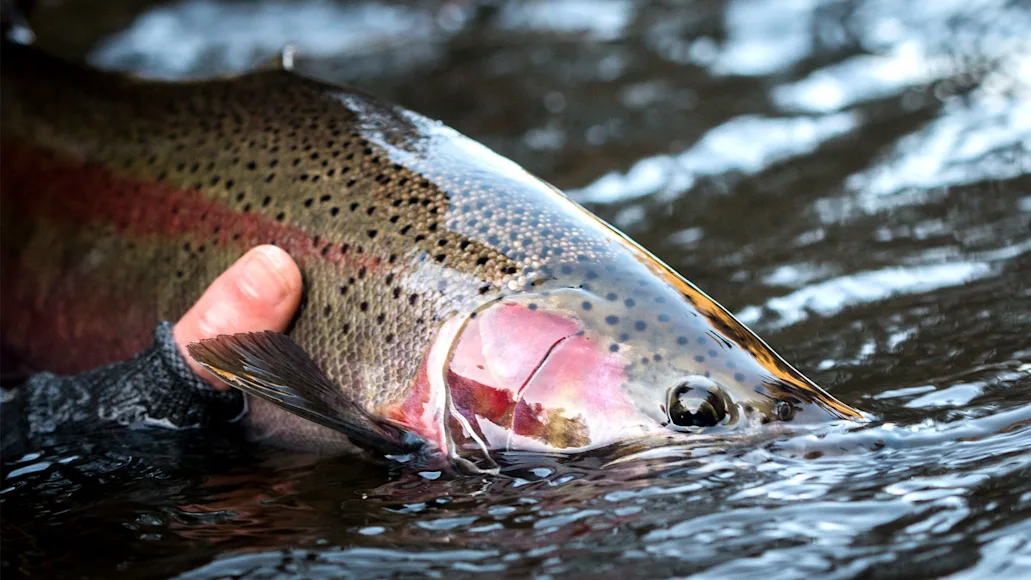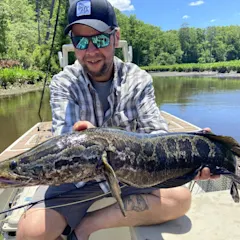CLEVELAND, BUFFALO, AND ROCHESTER, N.Y., have two things in common. In recent years, they have all made various top 10 lists of the fastest-dying cities in America. They are also three of the cities my friend Mark Wizeman and I drove past last November on a 410-mile Great Lakes steelhead fishing road trip. In a region where industry has largely moved away, leaving behind crumbling buildings and abandoned warehouses, the steelhead, one of the most sought-after gamefish in moving water, remains and thrives.
We had talked about it for a few years—packing the truck for an eight-day tour of the tributaries that once powered iron foundries and flowed past monolithic grain elevators and humming automobile plants. Like the immigrants that once filled these factories on the shores of the Great Lakes, the steelhead are transplants, too. They will never have saltwater running over their gills, but their fighting ability is no different from that of their West Coast kin. Though their tactics and attitudes vary, the anglers who chase the only steel that hasn’t rusted in this part of the country are just as driven.
Salmon River: Post-Snag Steelies
The faint sunlight showing through a sky dense with cold, gray clouds is about gone. It’s difficult to pick out where my fly line meets the water in the darkened riffle, yet somehow a slight tick registers and suddenly there is a 15-pound steelhead with my egg fly neatly in the corner of its mouth 4 feet out of the water, lunging straight at me. I have hooked seven steelhead in New York’s Salmon River today, and landed exactly one a quarter of the size of this fish. I know this will be my last hookup of the day. I’m facing the same obstacles I did with the other six: There are multiple root snarls that this steelhead can run into, and it’s pulling against the 4-pound-test tippet necessary to fool these wary trout in the clear water. I am fully aware that the odds are not in my favor as the fish changes direction and tears off downstream.

Gary Edwards ties on a Salmon River pattern. (Joe Cermele and Mark Wizeman)
“He just hit go home in his mental GPS,” says Gary Edwards with a laugh. “He’s going straight back to Lake Ontario.” The 59-year-old veteran guide, one of the first 10 to ever launch a float boat on the Salmon River, takes off on a sprint downstream with the net as he has thousands of times before in his 30-year career. I have no choice but to follow. My backing is half gone and the fresh chromer isn’t about to turn around.
The Salmon is one of the more notorious steelhead rivers on the Great Lakes. Cutting through Pulaski, a town that from the 1840s until recently was home to more than a hundred wood mills, ironworks, and factories, the Salmon River was named for its natural runs of Atlantic salmon. Like the factories and mills, those salmon were largely wiped out after chinook and coho salmon and steelhead were introduced to Lake Ontario in the mid 1960s and became apex predators. That stocking ultimately turned Pulaski into a place where thousands of snaggers lined the banks on Saturdays to throw weighted treble hooks during the fall run, fill coolers, and go home. Many of those salmon were sold commercially, and according to Edwards, the river was rampant with fistfights, petty sabotage, and cutthroat tactics to lock up the best holes and kill the most fish.
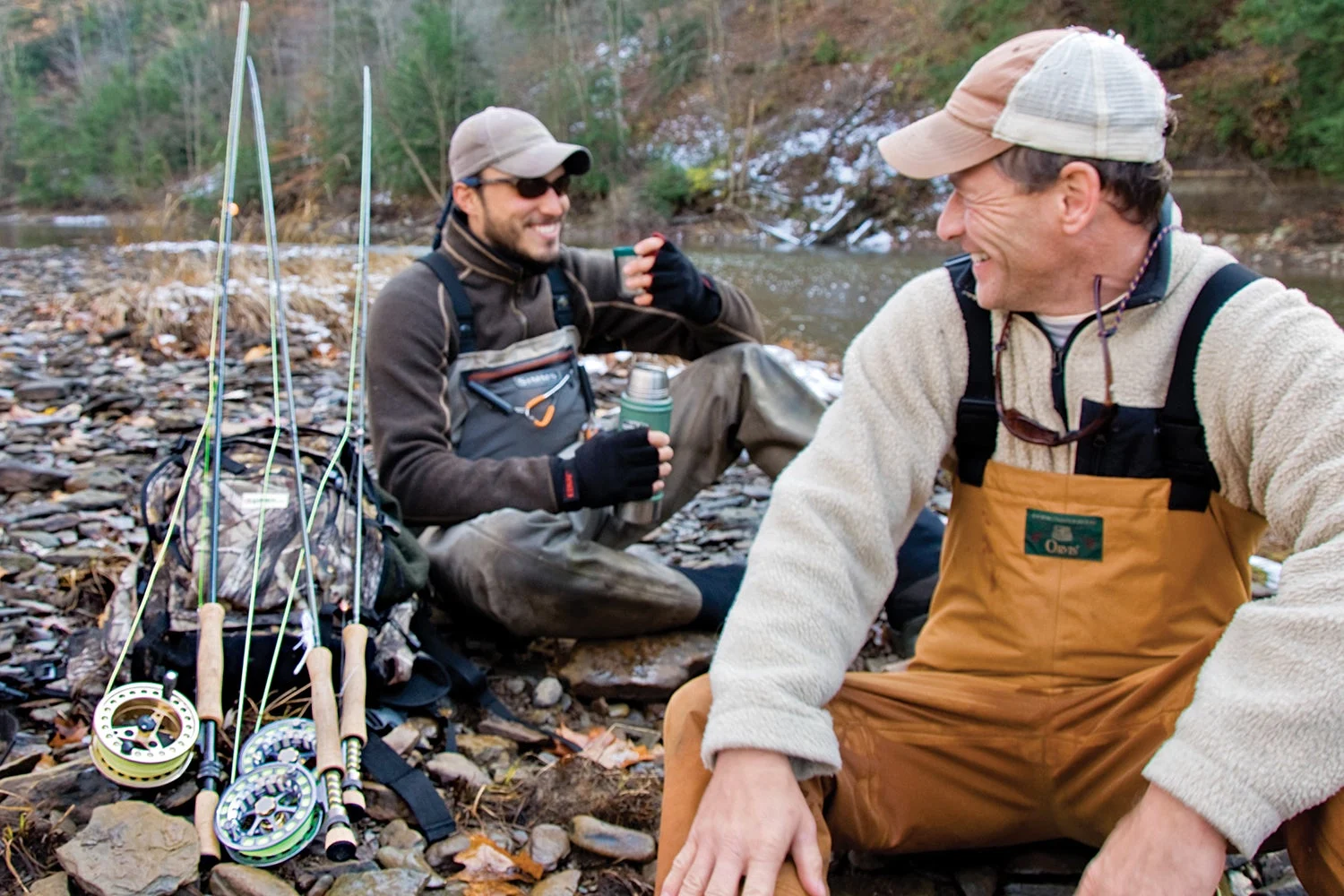
Mark Wizeman and Jeff Kreager on the Grand River. (Joe Cermele and Mark Wizeman)
Back then, pursuing steelhead largely took a backseat to salmon. Thanks to the illegalization of snagging, as well as guides like Edwards who repainted Pulaski as a destination for conservation-minded sportsmen, and an ever growing infatuation with steelhead, the situation has changed. Pulaski is still economically reliant on anglers. But these days, instead of heavy rods and snag hooks at the tackle shop, anglers are buying Spey rods, shiny Estaz Egg patterns, and tapered leaders at the fly shop.
If there is a visible testament to the attitude shift in Pulaski, it’s the Douglaston Salmon Run—a 2½-mile private stretch of river on the property of former State Sen. Doug Barclay. In the late 1980s, tired of hundreds of blatant trespassers leaving garbage on his property, Barclay, along with guides like Edwards, saw the opportunity to create a new fishery that would weed out the riffraff and take some strain off the highly pressured fish. To fish here you must pay a daily fee, and a limited number of anglers are allowed. There is a strict no-kill steelhead policy, and leader lengths are capped at 48 inches to make it harder for the occasional bad seed to sweep a fly at the end of a run in an attempt to snag.

A spawn sac bait. (Joe Cermele and Mark Wizeman)
The move made Barclay public enemy No. 1 among local anglers for years. Today, the Douglaston Salmon Run is viewed as a blessing that allows serious fishermen to avoid the shoulder-to-shoulder combat that takes place upriver. Though you can still spot crusty balls of heavy monofilament from decades past wrapped in the trees, the anglers who fish Douglaston are a new breed. There are smiles instead of scowls; advice instead of middle fingers; Orvis waders instead of worn-out rubber hip boots. When Wizeman hooked a fat 12-pound steelie earlier in the day, adjacent anglers considerately moved out of his way and offered congratulations when Edwards sunk the net on it a quarter mile downriver from where it was hooked.
Now Edwards is trying desperately to do the same with my last fish. “Not too much pressure. Turn your rod to the left,” he instructs. He is nearly armpit deep, 40 feet downstream in the final shafts of light. We have followed the steelhead for 200 yards, and now it is lolling on the surface but won’t let me bring it closer. Then, with a quick headshake, the big steelhead snaps my line and splashes away. Edwards, his net still extended, looks at me and says, “Hey, that was some fight though, wasn’t it?”
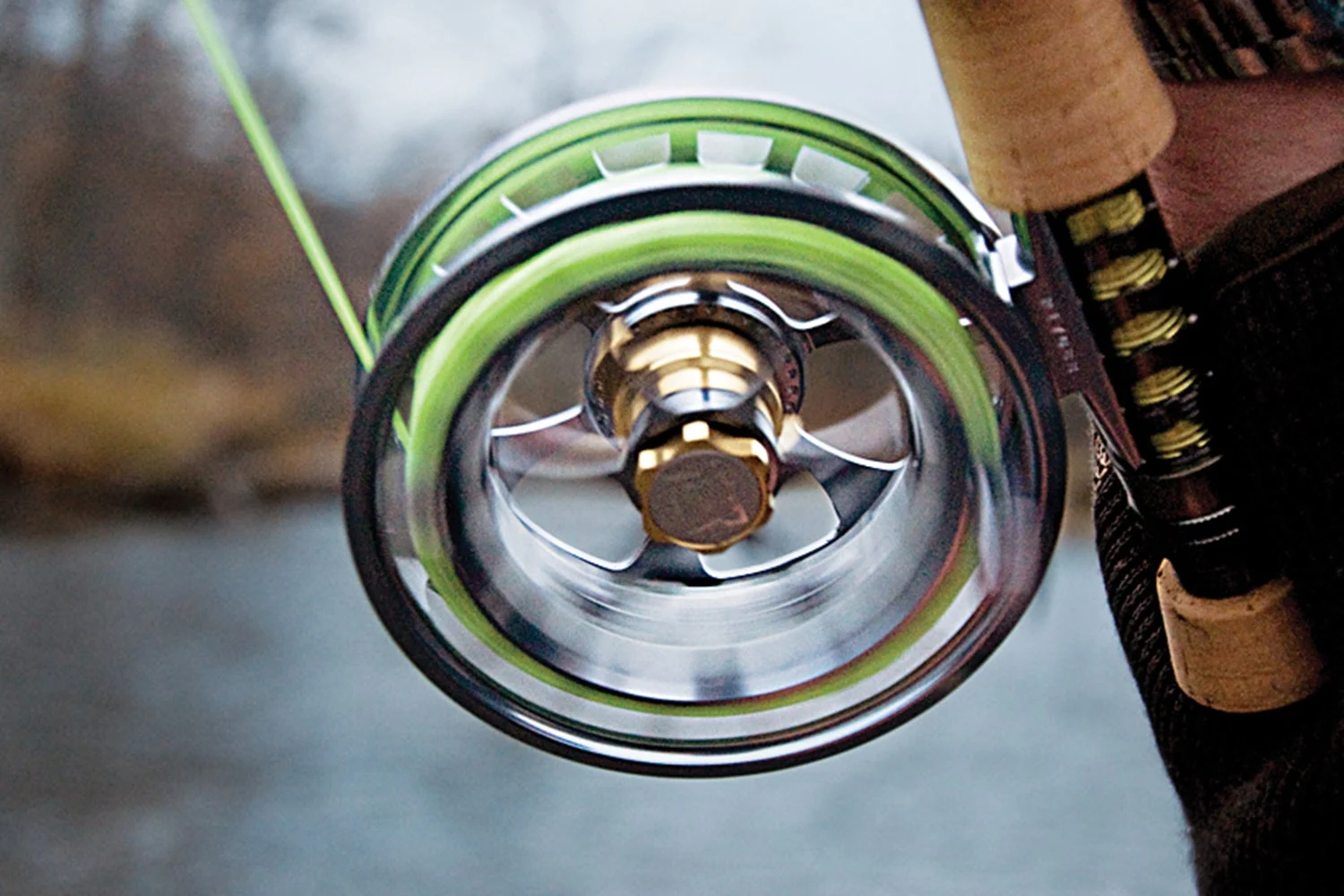
A 7-weight reel with 200 yards of backing—necessary for long runs. (Joe Cermele and Mark Wizeman)
Niagara River: Generating Fish
While strike indicators and nymphs are a key part of a Pulaski fly guide’s arsenal, 200 miles west in the quaint town of Lewiston, N.Y., electric fillet knives and Tupperware containers of home-cured egg sacs are standard issue. There are no fly shops on the banks of the mighty Niagara River, no drift boats. Here, there is a fish-cleaning house paid for by the charter fishing association at Lewiston Landing where, every day from September through April, anglers launch beefy Lunds capable of handling the wind chop, vortexes, and extreme currents produced by a deep river moving millions of gallons of water through a relatively narrow gorge every minute. As I help friend and guide Ted Kessler launch his boat, the odor from the cleaning house suggests the steelhead bite has been good.
We are only on the drift for 10 minutes, bouncing brown trout egg sacs freshly dyed hot pink along the rocky bottom on three-way rigs with conventional gear, when Wizeman rears backs. His rod bucks three times, then curls into a deep arc. “Lake trout,” Kessler grunts. He can tell the fish isn’t a steelie because it’s peeling line slowly instead of ripping it away like a greyhound on steroids. A few minutes later, Wizeman brings in a 15-pound laker. We boat three more before Kessler decides there are too many spawning lake trout in the area, and it’s going to be a real chore picking through them to hit the steelhead. We move.

Wizeman battles a Niagara fish. (Joe Cermele and Mark Wizeman)
Having fished the area his whole life, Kessler is unfazed by the whirling Niagara. At 30 mph, I feel the back of the boat fishtail when Kessler runs over one of the many swirling holes that open and close in the turquoise flow. He tells us it’s the Lewiston stretch, where the bodies of most suicide jumpers at Niagara Falls 10 miles upriver eventually resurface. Over our heads, the bridge to Canada is jammed with semitrucks backed up at customs. Ahead, flanking each side of the river, are the 400-foot-high concrete walls of American and Canadian power-generating stations. Strings of power lines create spiderwebs in the cloudless blue sky. Wizeman and I trade concerned looks as Kessler noses the boat into the shooting discharge of the American station a mere 6 feet from the opening of one of the concrete tunnels. “Why are my legs vibrating?” I ask. “That’s from the turbines below us,” Kessler says, grinning. “You can feel the rumble through the deck. Pretty wild, right, dude?”
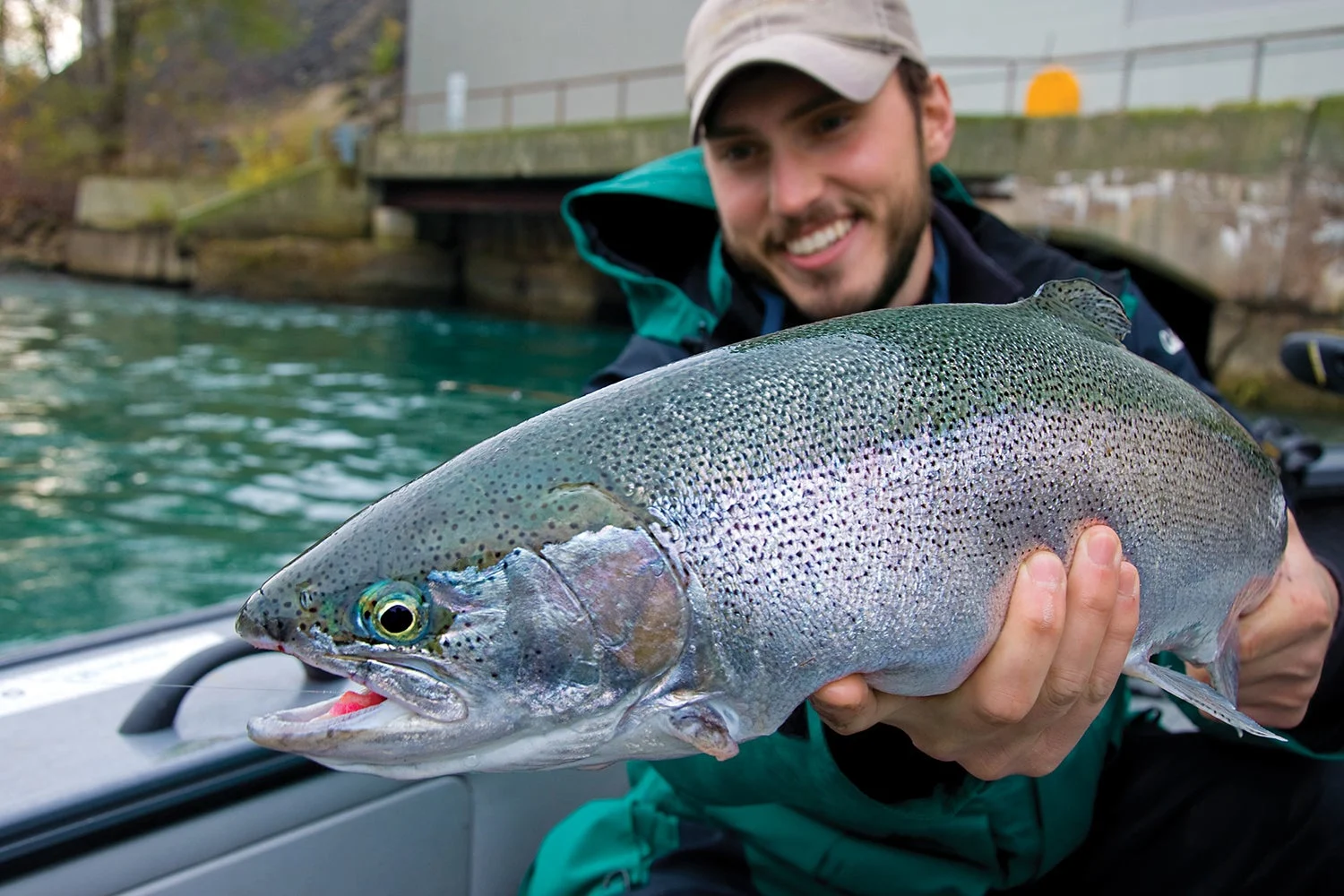
Wizeman with a Niagara River 10-pounder. (Joe Cermele and Mark Wizeman)
There is method to Kessler’s madness. The last tunnel in the chain is pumping, but it’s spitting out a slower stream of water than the center tunnels. “Every time this one is bubbling, I catch fish,” he happily announces as he works the trolling motor to keep us positioned in the slop. Wizeman and I send our spawn sacs down, and it’s almost automatic. I get bumped and miss, but Wizeman connects. His drag sings for a few beats, then a hefty steelhead shoots up through the confused white froth, hanging in the air. “Yeah, baby!” shouts Kessler. We get pushed out of the chute and spin wildly for 10 seconds in the main current until Kessler gets control with the big engine. Wizeman’s fish is streaking to the bottom and we’re all hooting at the chaos. By the time the 10-pounder is in the net, we’re a mile downriver. “O.K. Let’s get back to the fish factory,” Kessler says. For the next three hours, at least one of us ties into a steelhead with each drop into the churning power-plant cauldron.
By sunset, we’ve probably lost 30 rigs to the jagged bottom of the Niagara, but that’s all part of the game. We’ve also landed 23 steelhead, many of which broke 10 pounds. When we say our good-byes at the ramp, I commend Kessler on his fearless boat handling. “Hey man,” he says, “sometimes to get the fish around here, you can’t be afraid to rub a little concrete.”
Elk Creek: Low Blows
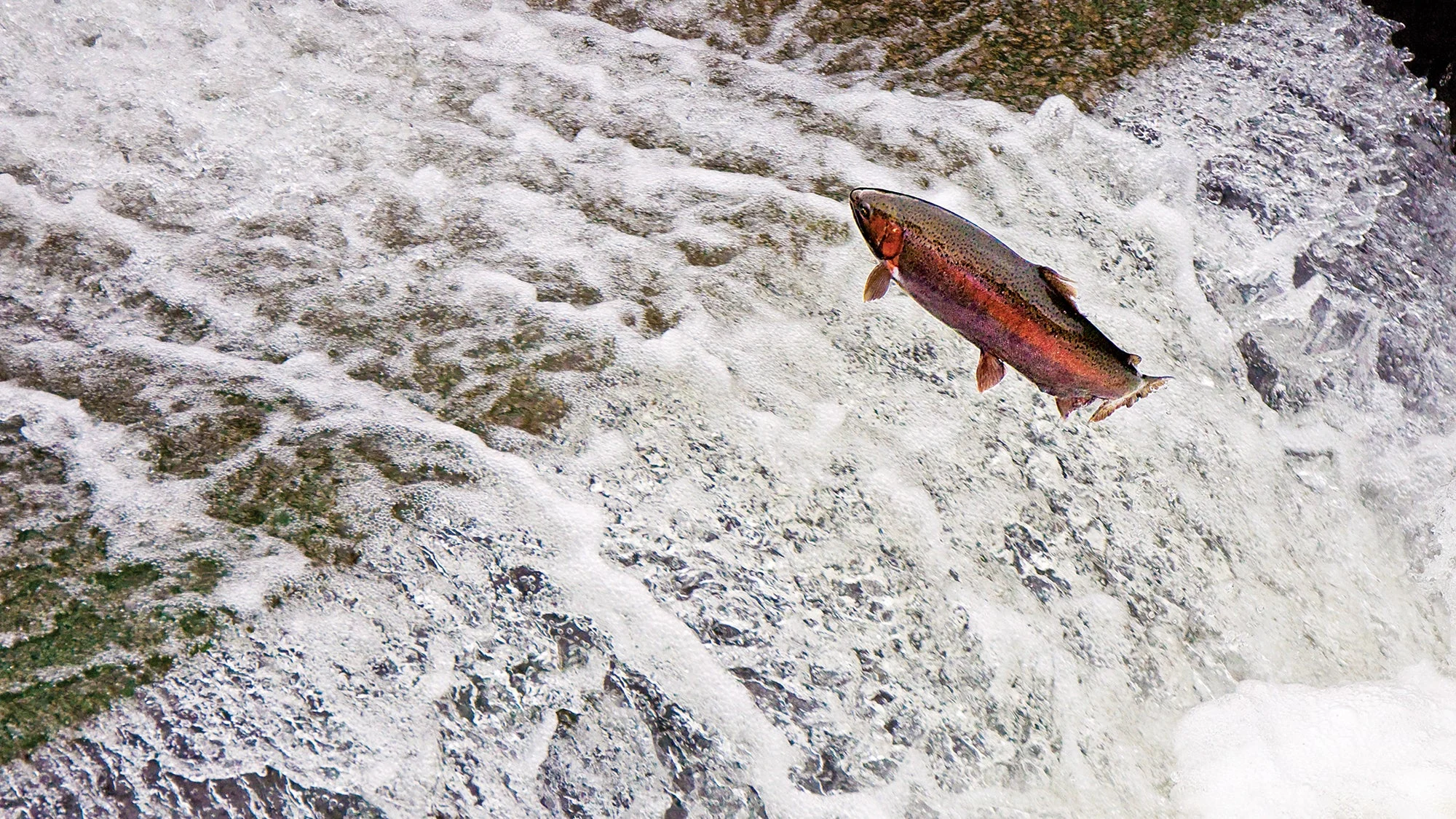
A Pennsylvania steelhead jumps a dam. (Joe Cermele and Mark Wizeman)
“I think it’s about time to go make those cookies,” Mark DeFrank shouts, a cigarette quivering in his lips. He is sitting on a rock at Elk Creek near Erie, Pa., in the heart of “Steelhead Alley.” Behind him, Wizeman and I stand as still as statues with his partner, guide Chris Kazulen, watching a little lady in sweatpants, sneakers, and a trout vest 30 feet downstream. She is standing on the shale bank in the early sun, trying to lob a nymph under a strike indicator into a short pool black with steelhead. But she can’t reach. She told us when we arrived that she was a lunch lady at a local school getting in a few hours of fishing before work, where she’d have to bake six dozen cookies this morning. DeFrank and Kazulen are itching to get at those fish, and polite banter has given way to agitation. They want the run. She knows it, and she’s not budging.
Elk Creek is shockingly low and crystal clear from a lack of rain. The bulk of the steelhead that pushed up from Lake Erie at high water are now trapped in the few-and-far-between runs that are at least 2 feet deep. I look up and down the meager flow, which is about 30 feet across at its widest point here. Every so often a steelhead back breaks the surface in the shallows. It looks too easy, but when the cookie lady finally concedes the hole, I learn quickly that I’m wrong.
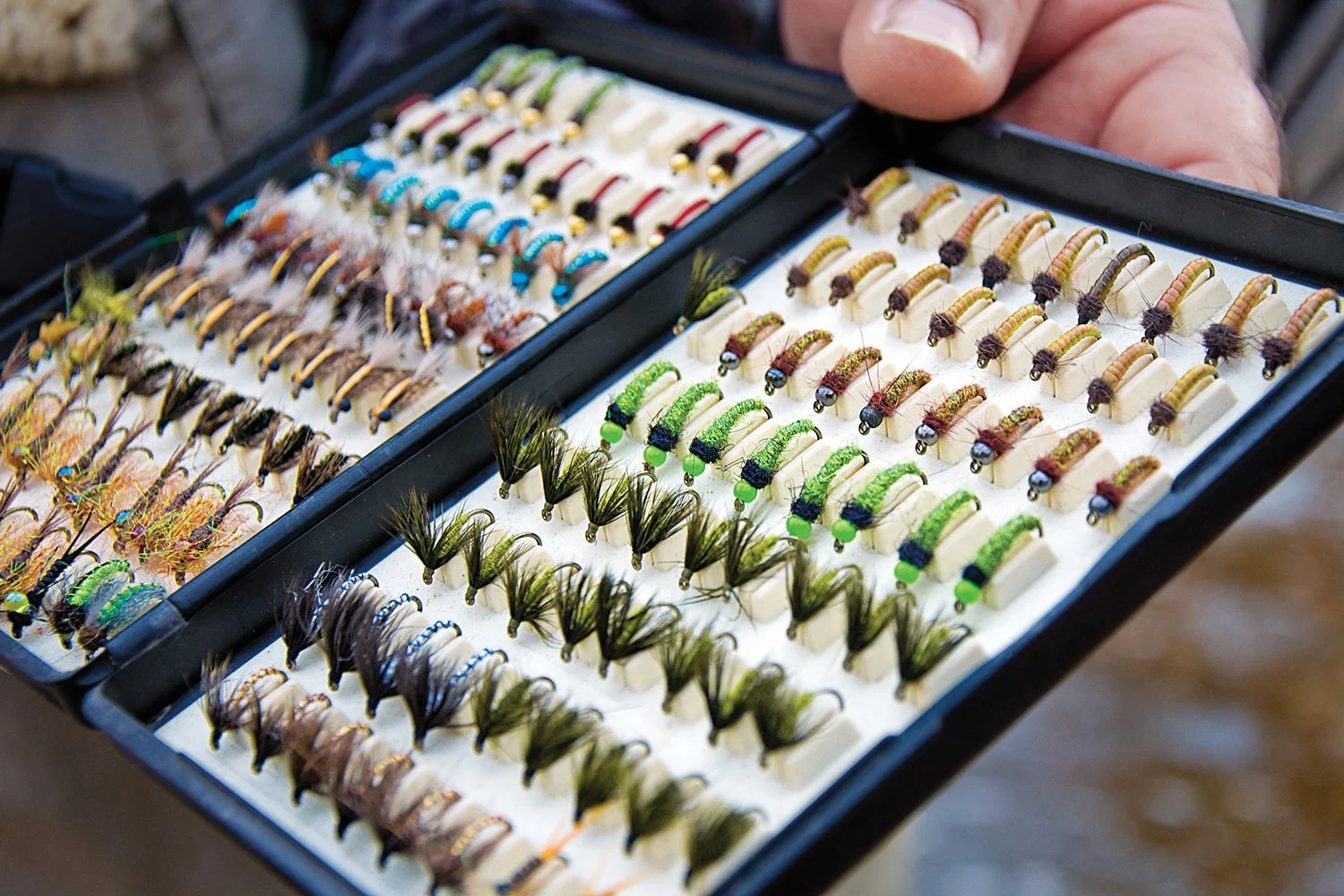
An Elk Creek fly box. (Joe Cermele and Mark Wizeman)
I step into the water with a tiny size 22 Brassie fly on the end of my 4-pound tippet. My first drift goes untouched. On the next, the little bobber dives. We’re all hoping I haven’t snagged a fish, which is easy to do when they’re this concentrated, but it takes Kazulen only a moment of watching the fight to know I’ve got it in the mouth. I’ve found an eater. Problem is, it’s a big fish with nowhere to go. For a hairy five minutes I gently keep up the pressure as the ticked-off trout shoots from one end of the pool to the other. If it breaks into one of the 6-inch riffles above or below, I’ll lose it. Eventually, Kazulen sloshes into the hole and takes a wild swing with the net. What he comes up with is the biggest steelhead I’ve ever landed—a glistening female pushing 18 pounds.
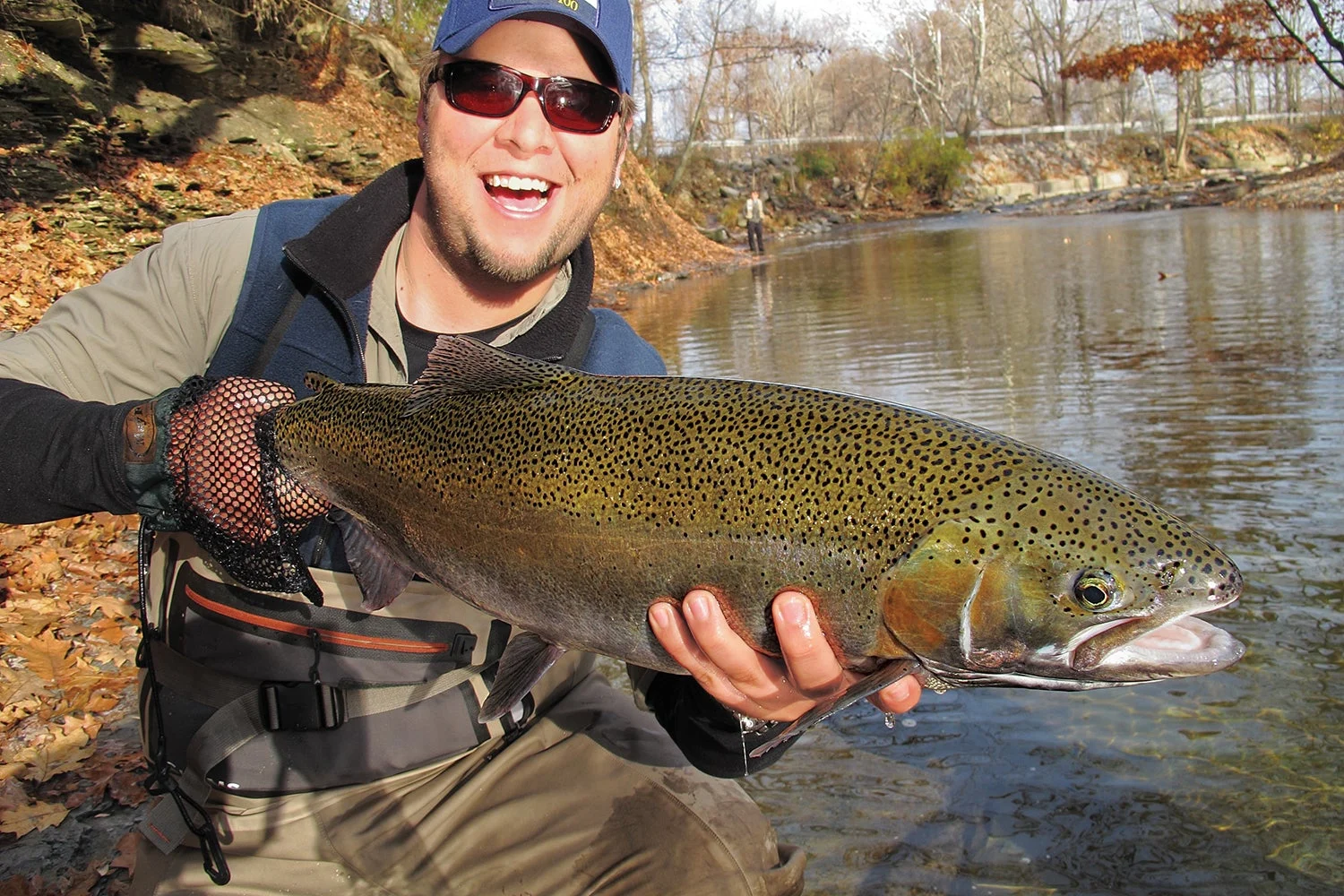
The author hefts a pretty 18-pounder from Elk Creek. (Joe Cermele and Mark Wizeman)
Our two guides are like the Laurel and Hardy of Pennsylvania steelheading. DeFrank, a master fly-tier whose steelhead box looks as though it should be propped open under glass in an art gallery, is short and stocky, and gripes about “vultures” (people that cast over your shoulder) and “mup ears” (people from Pittsburgh that “come mup ear” on weekends). Kazulen is tall and lanky, and talks about food incessantly. They bicker like brothers, but between DeFrank’s skill at fly selection and Kazulen’s eagle eyes, they are a deadly force on the water. At least five times throughout the day, Kazulen will spot lone steelhead in small depressions and riffles that Wizeman and I walk right by.
Thing is, spotting loners and catching them are two different animals. If your first cast isn’t dead on, you’re going to either spook the fish or snag it. When they do eat, all you get is the slightest head movement to the side, the mouth barely opening wider than when they take a breath. If you had plenty of room to roam and countless chances, it wouldn’t be so bad, but miles and miles of Pennsylvania’s steelhead creeks cut through private properties, some of which charge anglers to fish, and stretches can book up years in advance. And public water can get busy quickly: As we round a bend, two anglers heading in the other direction tell us not to go any farther. The landowner who usually grants fishermen access is on a bender today and threatening to call the cops on anyone he sees behind the house, because someone left broken beer bottles along the creek.

The anglers’ four stops. (Map by Pete Hoey)
We return to a pool where we spotted a half dozen fish nervously cruising, and as we’re trying to get one to eat, an old man approaches from the bank. He’s carrying a beat-up fly rod and reel, and dangling from the end of what must be a straight length of 20-pound mono is a large Woolly Bugger. I count four big split shot only 6 inches above the fly. “Look who it is! Capt. Snag-O-Plenty,” Kazulen yells at the man. The old-timer smiles. “Is good fishing?” he asks in a thick Russian accent. When he makes two lobs right between us, we decide it’s time to go. “You saw how hard the fishing was today, right?” Kazulen asks me as we walk out. “By the time we get our waders off, he’ll be at his car with a limit of fish, you watch.”
Later that day we bump into a Pennsylvania Fish and Boat Commission officer at the mouth of Walnut Creek—the state’s other noted steelhead tributary. He shows us three homemade snag hooks he’s confiscated in the last few days. “It’s only Wednesday,” the officer says with a sigh. “I’ll have a lot more after the weekend.”
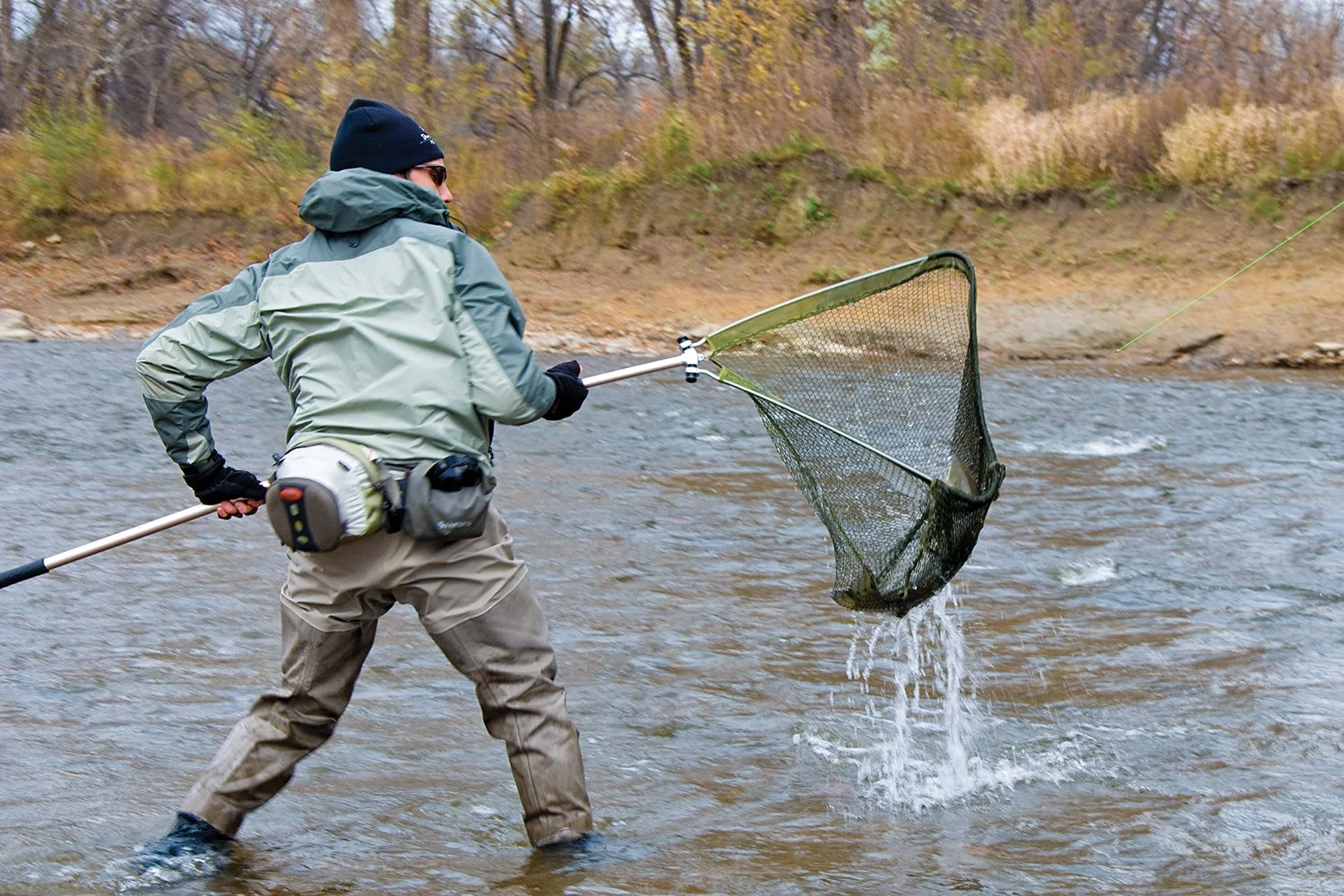
Wizeman nets a Grand River fish. (Joe Cermele and Mark Wizeman)
Grand River: Downtown Drift
The next morning, Wizeman and I meet Jeff Kreager in the lobby of our shabby motel in Mentor, Ohio, just east of Cleveland. Kreager, a real estate agent from Newark, Ohio, is a longtime F&S reader who comments often on the magazine’s website. I knew he had experience in these waters and had asked him to play guide for a day, and he gladly accepted.
Though Kreager admits he is no steelhead expert, his enthusiasm is infectious. “I’ve never fished this spot before,” he says when we pull up to a stretch of the Grand River in downtown Painesville, “but it looks pretty good.” There are other flyfishermen walking the trails at the municipal park as we suit up behind Kreager’s Jeep, warming up on this cold morning with a nip of peach Schnapps from his flask. We find a quiet pool outside the main current and spread out along the run, each drifting a sucker spawn fly in a different color down the stained Grand.

Kreager drifts a run in Ohio’s Grand River. (Joe Cermele and Mark Wizeman)
The water level is good, and everything feels fishy. Even the sudden snow squall that pelts us for 20 minutes signals steelhead. Every time my indicator stops, my heart jumps. But it is our host who finds more than a rock tugging down his float. The big bright female jumps in the center of the pool. Wizeman runs for the net. Kreager takes off downstream behind a fly rod bowed to the brink. “Fighting a steelhead is like fighting a rabbit,” he yells over his splashing boots. The three of us are having such a great time that it feels as though we’ve been fishing together for years. We won’t catch another fish after netting Kreager’s 12-pounder, but we’re all pleased—his steelie is a team victory.
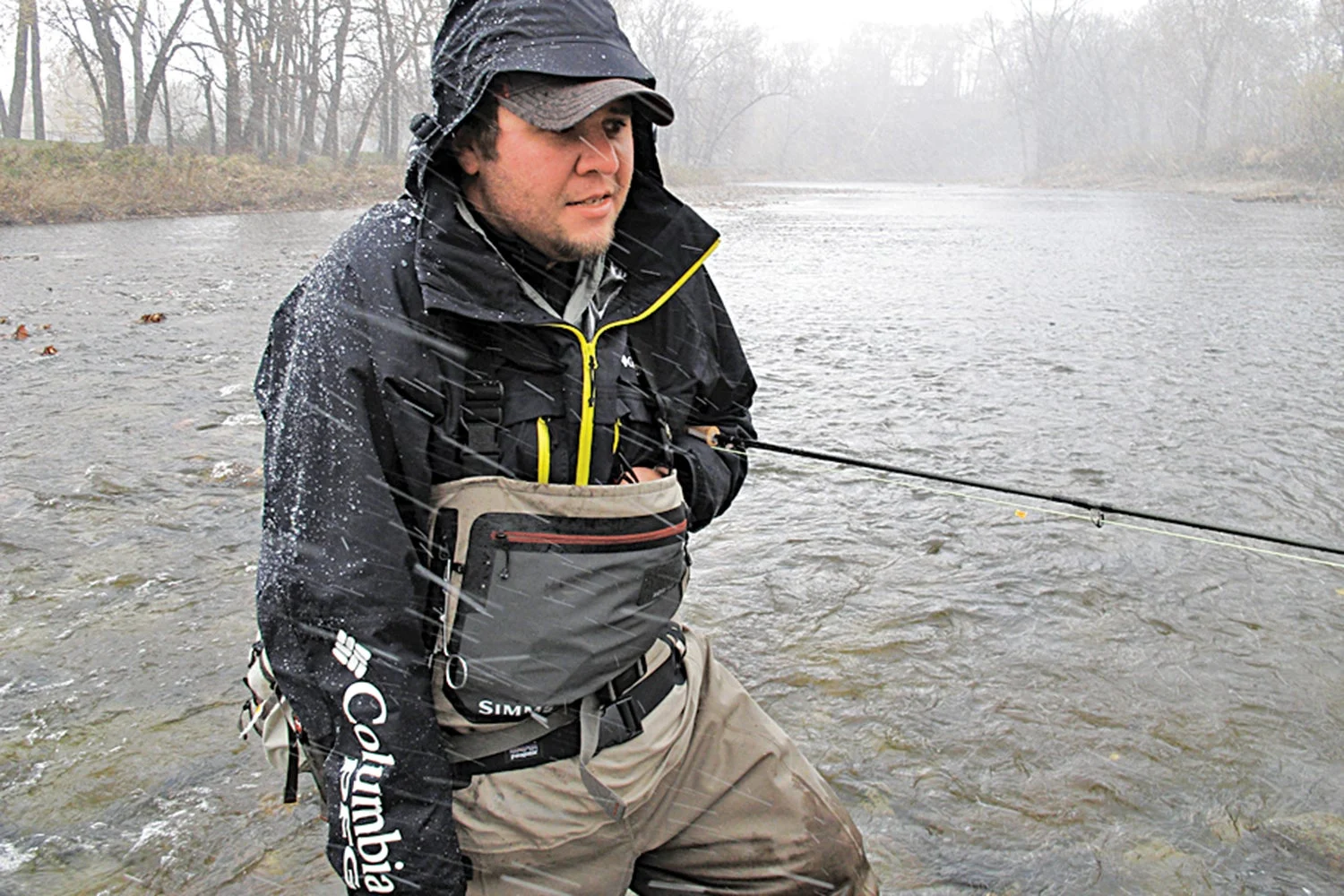
The author warms his hands during a snow squall. (Joe Cermele and Mark Wizeman)
It’s about four-thirty when we sit down on the bank, and Kreager opens two tins of Beach Cliff Fish Steaks in Louisiana Hot Sauce and doles out coffee from his thermos. We get on a subject other than steelhead, laughing and joking as the Grand flows by. It flows under the highway locked up with commuters heading home from Cleveland, then beneath the railroad bridge in Painesville that once carried train cars loaded with steel and iron ore. Then the Grand will become slow and muddy as it dumps into Lake Erie, where anglers from miles around are hoping a fresh school of steelhead is staging, getting ready to push upstream this weekend.
This story originally appeared in the October 2012 issue.

